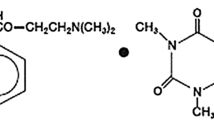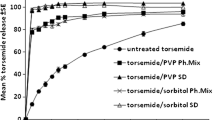Abstract
For a drug with low bioavailability, a matrix tablet with liquid permeation enhancer (Labrasol®) was formulated. Factorial design was used to evaluate the effect of three formulation factors: drug percentage, polymer type (Methocel® K100M or Eudragit® L 100-55), and tablet binder percentage (Plasdone® S-630) on tablet characteristics. Tablets were prepared by direct compression and characterized. Compressibility index values ranged between 15.90% and 29.87% and tablet hardness values from 7.8 to 29.78 Kp. Eudragit®-containing formulations had better compressibility index values with higher tablet hardness. Time for 75% of drug release (T 75) was calculated, and formulations containing Eudragit® L 100-55 had faster release rates than tablet formulations with Methocel® K100M. Formulations with Methocel® K100M fit well in the Higuchi model as indicated by their R 2 values (>0.98). Among all the formulation factors studied, polymer type displayed the highest and statistically significant effect on compressibility index, tablet hardness, and dissolution rate. Statistical design helped in better understanding the effect of formulation factors on tablet characteristics important for designing formulations with desired characteristics.






Similar content being viewed by others
References
Aungst BJ. Novel formulation strategies for improving oral bioavailability of drugs with poor membrane permeation or presystemic metabolism. J Pharm Sci. 1993;82(10):979–87.
Irwin GM, Kostenbauder HB, Dittert LW, Staples R, Misher A, Swintosky JV. Enhancement of gastrointestinal absorption of a quaternary ammonium compound by trichloroacetate. J Pharm Sci. 1969;58(3):313–5.
Caramazza I, D'Atri G, Bossi ML, De Ponti F, D'Angelo L, Crema A. Intraduodenal absorption of the new UF-heparin salt ITF 1057 in the conscious dog. Thromb Res. 1991;62(6):785–9.
Levy G, Reuning RH. Effect of complex formation on drug absorption. I. Complexes of salicylic acid with absorbable and nonabsorbable compounds. J Pharm Sci. 1964;53:1471–5.
Uekama K, Narisawa S, Hirayama F, Otagiri M. Improvement of dissolution and absorption characteristics of benzodiazepines by cyclodextrin complexation. Int J Pharm. 1983;16(3):327–38.
Sharma P, Varma MV, Chawla HP, Panchagnula R. Absorption enhancement, mechanistic and toxicity studies of medium chain fatty acids, cyclodextrins and bile salts as peroral absorption enhancers. Farmaco. 2005;60(11-12):884–93.
Pouton CW. Lipid formulations for oral administration of drugs: non-emulsifying, self-emulsifying and “self-microemulsifying” drug delivery systems. Eur J Pharm Sci. 2000;11(Suppl 2):S93–8.
Nazzal S, Nutan M, Palamakula A, Shah R, Zaghloul AA, Khan MA. Optimization of a self-nanoemulsified tablet dosage form of Ubiquinone using response surface methodology: effect of formulation ingredients. Int J Pharm. 2002;240(1–2):103–14.
Amidon GL, Lennernas H, Shah VP, Crison JR. A theoretical basis for a biopharmaceutic drug classification: the correlation of in vitro drug product dissolution and in vivo bioavailability. Pharm Res. 1995;12(3):413–20.
Yuksel N, Karatas A, Ozkan Y, Savaser A, Ozkan SA, Baykara T. Enhanced bioavailability of piroxicam using Gelucire 44/14 and Labrasol: in vitro and in vivo evaluation. Eur J Pharm Biopharm. 2003;56(3):453–9.
Rama Prasad YV, Eaimtrakarn S, Ishida M, Kusawake Y, Tawa R, Yoshikawa Y, et al. Evaluation of oral formulations of gentamicin containing Labrasol in beagle dogs. Int J Pharm. 2003;268(1-2):13–21.
Djordjevic L, Primorac M, Stupar M, Krajisnik D. Characterization of caprylocaproyl macrogolglycerides based microemulsion drug delivery vehicles for an amphiphilic drug. Int J Pharm. 2004;271(1–2):11–9.
Koga K, Kusawake Y, Ito Y, Sugioka N, Shibata N, Takada K. Enhancing mechanism of Labrasol on intestinal membrane permeability of the hydrophilic drug gentamicin sulfate. Eur J Pharm Biopharm. 2006;64(1):82–91.
Ito Y, Arai H, Uchino K, Iwasaki K, Shibata N, Takada K. Effect of adsorbents on the absorption of lansoprazole with surfactant. Int J Pharm. 2005;289(1–2):69–77.
Ito Y, Kusawake T, Ishida M, Tawa R, Shibata N, Takada K. Oral solid gentamicin preparation using emulsifier and adsorbent. J Control Release. 2005;105(1–2):23–31.
Ito Y, Kusawake T, Prasad YV, Sugioka N, Shibata N, Takada K. Preparation and evaluation of oral solid heparin using emulsifier and adsorbent for in vitro and in vivo studies. Int J Pharm. 2006;317(2):114–9.
Cabot-Corporation. Untreated fumed silica: Cab-O-Sil EH5. Cabot Corporation 2006.
Takka S, Singh Bharaj S, Sakr A. Influence of methacrylic acid and hydroxypropylmethyl cellulose on the tablet properties and in vitro release of dextromethorphan hydrobromide. Die Pharmazie. 2003;58(12):886–90.
Nellore RV, Rekhi GS, Hussain AS, Tillman LG, Augsburger LL. Development of metoprolol tartrate extended-release matrix tablet formulations for regulatory policy consideration. J Control Release. 1998;50(1–3):247–56.
Solinis MA, de la Cruz Y, Hernandez RM, Gascon AR, Calvo B, Pedraz JL. Release of ketoprofen enantiomers from HPMC K100M matrices—diffusion studies. Int J Pharm. 2002;239(1–2):61–8.
Gambhire MN, Ambade KW, Kurmi SD, Kadam VJ, Jadhav KR. Development and in vitro evaluation of an oral floating matrix tablet formulation of diltiazem hydrochloride. AAPS PharmSciTech. 2007;8(3):E73.
Takka S, Rajbhandari S, Sakr A. Effect of anionic polymers on the release of propranolol hydrochloride from matrix tablets. Eur J Pharm Biopharm. 2001;52(1):75–82.
Moroni A. A Novel Copovidone Binder for Dry Granulation and Direct-Compression Tableting. Pharm Technol. 2001;25(9):8–12.
Gao JZ, Jain A, Motheram R, Gray DB, Hussain MA. Fluid bed granulation of a poorly water soluble, low density, micronized drug: comparison with high shear granulation. Int J Pharm. 2002;237(1–2):1–14.
Khanvilkar KH, Huang Y, Moore AD. Influence of hydroxypropyl methylcellulose mixture, apparent viscosity, and tablet hardness on drug release using a 2(3) full factorial design. Drug Dev Ind Pharm. 2002;28(5):601–8.
Akin-Ajani OD, Itiola OA, Odeku OA. Effects of plantain and corn starches on the mechanical and disintegration properties of paracetamol tablets. AAPS PharmSciTech. 2005;6(3):E458–63.
Nazzal S, Khan MA. Controlled release of a self-emulsifying formulation from a tablet dosage form: stability assessment and optimization of some processing parameters. Int J Pharm. 2006;315(1–2):110–21.
Moore JW, Flanner HH. Mathematical comparison of dissolution profiles. Pharm Technol. 1996;20(6):64–75.
Narendra C, Srinath MS, Babu G. Optimization of bilayer floating tablet containing metoprolol tartrate as a model drug for gastric retention. AAPS PharmSciTech. 2006;7(2):E34.
Carr RL. Evaluating flow properties of solids. Chem Eng. 1965;72:163–8.
USP31-NF26. Chapter 1174 Powder flow. USP31–NF26 ed. Rockville, MD 2009:618.
Schulze MD, Williams RO, McGinity JW. Compaction properties of acrylic resin polymers with plastic and brittle drugs. Drug Dev Ind Pharm. 1990;16(5):741–54.
Tatavarti AS, Muller FX, Hoag SW. Evaluation of the deformation behavior of binary systems of methacrylic acid copolymers and hydroxypropyl methylcellulose using a compaction simulator. Int J Pharm. 2008;348(1–2):46–53.
Costa P, Sousa Lobo JM. Modeling and comparison of dissolution profiles. Eur J Pharm Sci. 2001;13(2):123–33.
Mehta KA, Kislalioglu MS, Phuapradit W, Malick AW, Shah NH. Release performance of a poorly soluble drug from a novel, Eudragit-based multi-unit erosion matrix. Int J Pharm. 2001;213(1–2):7–12.
Higuchi T. Physical chemical analysis of percutaneous absorption process from creams and ointments. J Soc Cosmet Chem. 1960;11:85–97.
Higuchi T. Rate of release of medicaments from ointment bases containing drugs in suspension. J Pharm Sci. 1961;50:874–5.
Higuchi T. Mechanism of sustained-action medication. Theoretical analysis of rate of release of solid drugs dispersed in solid matrices. J Pharm Sci. 1963;52:1145–9.
Oren PL, Seidler WMK, inventors; Sustained release matrix patent 1990, 4,968,508.
Acknowledgements
This project has been supported with funds from the U.S. National Institute of Allergy and Infectious Diseases, National Institutes of Health, Department of Health and Human Services, under Contract No. HHSN26620050047C. The authors wish to thank Ms. Manjula Prasad and Dr. Jane Han for the HPLC analysis of the dissolution samples.
Author information
Authors and Affiliations
Corresponding author
Rights and permissions
About this article
Cite this article
Bejugam, N.K., Parish, H.J. & Shankar, G.N. Influence of Formulation Factors on Tablet Formulations with Liquid Permeation Enhancer Using Factorial Design. AAPS PharmSciTech 10, 1437–1443 (2009). https://doi.org/10.1208/s12249-009-9345-8
Received:
Accepted:
Published:
Issue Date:
DOI: https://doi.org/10.1208/s12249-009-9345-8




